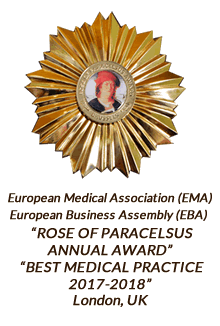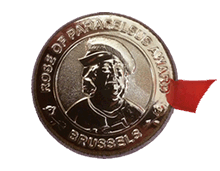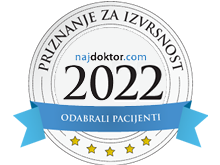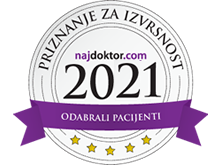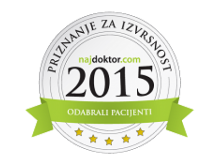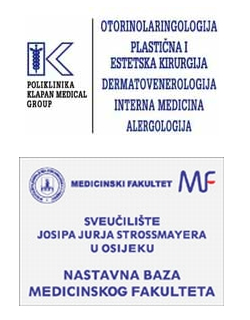Published as: Ivica Klapan et all., Am J Otolaryngol, 1999, 20:7-11.
Medical Institutions:
University Polyclinic Klapan Medical Group, Zagreb,
ENT Department Zagreb University School of Medicine,
ENT Department Zagreb University School of Medicine,
Pliva d.d. Pharmaceuticals Division; Zagreb, Croatia
Corresponding author:
Professor Ivica Klapan, M.D., Ph.D., University Polyclinic Klapan Medical Group, HR-10000 Zagreb, Croatia (poliklinika.klapan@vodatel.net)
Corresponding author:
Professor Ivica Klapan, M.D., Ph.D., University Polyclinic Klapan Medical Group, HR-10000 Zagreb, Croatia (poliklinika.klapan@vodatel.net)
ABSTRACT
A total of 100 adult patients with symptoms and signs of acute sinusitis, who have given their informed consent, were included in an open, comparative, randomized study. Clinical diagnosis of sinusitis was confirmed by nasal endoscopy and sinus radiography. Culture of sinus aspirate was performed when sinus puncture was indicated. Patients were randomized to receive azithromycin (500 mg once daily for 3 days), or amoxicillin/clavulanate (625 mg every 8 hours for 10 days). Control clinical examinations were performed 72 hours, 10-12 days and 4 weeks after the treatment initiation. At day 10-12, 95% of patients in azithromycin-, and 74% in amoxicillin/clavulanate group were cured. The remaining patients were improved. By the follow-up visit, cure was achieved in 98% of azithromycin-, and 91% of amoxicillin/clavulanate-treated patients. In 3 patients from amoxicillin/clavulanate group the treatment failed, and in one patient from each group the relapse was observed. Significantly faster resolution of signs and symptoms of sinusitis was observed in azithromycin-treated group. Bacteriological eradication was achieved in 23/23 and 21/24 patients treated with azithromycin and amoxicillin/clavulanate, respectively. Both drugs were well tolerated. Two patients (4%) from azithromycin, and 5 (10%) from amoxicillin/clavulanate group reported mild gastrointestinal disturbances. It may be concluded that in the treatment of acute sinusitis three-day azithromycin is as effective and well-tolerated as ten-day amoxicillin/clavulanic acid. Significantly simpler dosage regimen, and faster clinical effect are the advantages of azithromycin.
INTRODUCTION
Acute sinusitis is a frequent disease that usually occurs as a complication of viral upper respiratory tract infections or allergic inflammation.1 Both above mentioned conditions are associated with the swelling of mucosa that reduces the patency of sinus ostia, the impairment of ciliary action and mucus overproduction. These abnormalities frequently cause the retention of secretions within the sinus favoring a secondary bacterial infection and conversion of mucus to mucopus. Mucopus further impairs ciliary function and increases swelling around ostia creating a vicious circle.2 Therefore, the treatment of acute sinusitis must be grounded on antimicrobial therapy. It is usually selected on empirical basis, since an adequate specimen for bacteriological studies, sinus aspirate, could be obtained only by sinus puncture. According to current recommendations, chosen antimicrobial should cover common pathogens of acute sinusitis i.e. Streptococcus pneumoniae, Haemophilus influenzae and Moraxella catarrhalis.1,3,4 A number of antimicrobial agents have been shown to be effective in the treatment of acute sinusitis, but amoxicillin/clavulanic acid, second generation cephalosporins, or trimethoprim/sulfamethoxazole, all given orally for 10-14 days, are generally considered as the standard regimens.3,4 It is worth mentioning that the majority of patients with acute sinusitis are treated as outpatients. This fact highlights the compliance as the significant determinant of treatment outcome. Long duration of treatment has negative impact on compliance, and therefore, the principal disadvantage of standard regimens is extended duration of treatment course.
Azithromycin is an azalide antibiotic, structurally related to erythromycin. In comparison to parent compound, it has expanded gram-negative spectrum, especially excellent activity against H. influenzae. The pharmacokinetic profile of azithromycin is characterized with extensive tissue distribution and phagocytic delivery to inflamed tissues.5 It has been shown that in patients with sinusitis azithromycin achieves therapeutic concentrations in sinus fluid and mucosa.6 Long terminal half-life of approximately 68 hours enables once daily administration, and notable shortening of treatment course, since therapeutic tissue concentrations are maintained for 5-7 days after the cessation of administration.5 It has been already shown that 5-day azithromycin course is clinically successful in more than 90% of patients with acute sinusitis.7-9
The present study was undertaken in order to compare the efficacy and tolerability of 3-day azithromycin course and amoxicillin/clavulanic acid in the treatment of acute sinusitis in adults.
The present study was undertaken in order to compare the efficacy and tolerability of 3-day azithromycin course and amoxicillin/clavulanic acid in the treatment of acute sinusitis in adults.
PATIENTS AND METHODS
The study was open, comparative, and randomized. The protocol was approved by local Ethics Committee. Patients with acute sinusitis, older than 15 years, who have given their informed consent, were included. Diagnosis of sinusitis was established on the basis of clinical findings (the presence of signs and symptoms consistent with sinusitis that last shorter than 4 weeks), sinus radiography (opacities, mucosal thickening „4 mm, or fluid levels in affected sinuses), and nasal endoscopy (complete obstruction of ostiomeatal complex, or partial obstruction with purulent discharge).
Pregnant and lactating women were excluded as well as the patients with hypersensitivity to study drugs, severe renal or hepatic impairment, gastrointestinal disorders that may affect drug absorption, immunodeficiency, clinically significant viral infection, subchronic or chronic sinusitis, and patients who have received more than 1 daily dose of any antibacterial within 7 days prior to enrollment.
Patients were randomized to receive azithromycin, 500 mg once daily for 3 days, or amoxicillin/clavulanic acid, 625 (500/125) mg every 8 hours for 10 days.
Patients were randomized to receive azithromycin, 500 mg once daily for 3 days, or amoxicillin/clavulanic acid, 625 (500/125) mg every 8 hours for 10 days.
Clinical examination was performed at baseline and 72 hours, 10-12 days and 4 weeks after the treatment initiation. Clinical severity of sinusitis was evaluated at each visit, using scoring system presented in Table 1. The sum of all scores represented total clinical score (TCS). When sinus puncture was indicated, the culture of sinus aspirate was accomplished. Nasal endoscopy, sinus radiography, and laboratory tests (hematology, blood biochemistry, urinalysis) were done at baseline, and at day 10-12.
Clinical response was evaluated at the end of treatment (day 10-12), and at follow-up (4 weeks after the initiation of treatment). It was defined as cure (complete disappearance of signs and symptoms of sinusitis, TCS ¾1), improvement (partial disappearance of signs and symptoms, but without need for additional antimicrobial therapy), failure (persistence or progression of signs or symptoms, requiring the additional antimicrobial therapy), and relapse (reappearance of signs or symptoms during follow-up). Bacteriological response was evaluated as eradication (culture of sinus aspirate positive at baseline, and negative after 72 hours of treatment), presumed eradication (culture of sinus aspirate positive at baseline, and control culture was not performed due to complete clinical response), persistence (culture of sinus aspirate still positive after at least 72 hours of treatment), and superinfection (the emergence of new pathogen in culture of sinus aspirate after at least 72 hours of treatment).
Statistical analysis was made using SAS/STAT®.10 Two treatment groups were compared by Wilcoxon 2-sample test or 2-tailed Fisher's exact test for demographic and case history data; Cochran-Mantel-Haenszel statistics based on Ridit scores for clinical severity of sinusitis, and clinical and bacteriological response; and 2-tailed Fisher's exact test for the incidence of side-effects and treatment related laboratory abnormalities.
RESULTS
A total of 100 patients, aged 15-50 years, were included into the study. Fifty patients were randomized into each treatment group. Treatment groups were comparable with respect to demographic, case history, and baseline clinical data, Table 2. Bacteriological assessments were performed in 70 patients. Baseline bacteriological findings are presented in Table 3. H. influenzae was the leading pathogen, followed with S. aureus, S. pneumoniae and M. catarrhalis. In about one third of patients no pathogen was recovered in the culture of sinus aspirate.
Three patients from each group violated inclusion criteria and were excluded from the analysis of efficacy. Clinical response to therapy is presented in Table 4. At the end of therapy (day 10-12) satisfactory clinical response was observed in all patients, but significantly higher number of azithromycin-treated patients were cured (95 vs. 74%, p=0.012). By the follow-up assessment, cure was achieved in 98% of azithromycin-, and 91% of amoxicillin/clavulanate-treated patients (p>0.05). In 3 (7%) patients from amoxicillin/clavulanate group, the treatment failed since additional antimicrobial treatment was given due to persistence of signs and symptoms of sinusitis. In all of them clinical cure and bacteriological eradication were achieved with azithromycin. The relapse was observed in 1 (2%) patient from each group. Faster resolution of signs and symptoms of sinusitis was observed in patients treated with azithromycin. Namely, there was no significant difference in mean TCS between two treatment groups at baseline, but mean TCS was significantly lower in azithromycin group at day 4 (p=0.001), and at day 10-12 (p=0.042), Table 5.
There was no significant difference in bacteriological response between treatment groups (p=0.409). Eradication of initial pathogen was confirmed in 20/23, and presumed in 3/23 patients from azithromycin group. In amoxicillin/clavulanate group, eradication of initial pathogen was observed in 20/24, presumed eradication in 1/24, persistence in 2/24 (H. influenzae and Staphylococcus aureus, respectively), and relapse (S. aureus) in 1/24 patients.
Both drugs were well tolerated, and there were no treatment discontinuations due to side-effects. Two patients (4%) from azithromycin group reported mild, transient, gastrointestinal disturbances (nausea and vomiting, respectively), as well as 5 patients (10%) from amoxicillin/clavulanate group (nausea in 4, and nausea and diarrhea in 1). The difference was not statistically significant (p=0.436). Clinically significant laboratory abnormalities were not observed in any patient.
DISCUSSION
It is well known that noninfectious conditions that predispose to acute sinusitis include anatomic abnormalities of nasal cavity and allergic reactions in the nose. Indeed, in 36% of our patients endoscopic examination of nasal cavity revealed clinically relevant anatomic abnormalities of nasal septum or lateral nasal wall, and 30% of patients had the allergy in their medical history.
Concerning the etiology of acute sinusitis, our bacteriological findings generally correspond with literature data.1,3,4 The exception is surprisingly high incidence of S. aureus. It is interesting that all patients with S. aureus as a single pathogen had anatomic abnormalities of nasal cavity, suggesting the presence of subchronic or chronic form of illness. The observed proportion of negative findings is in accordance with some reports.11-13
The results of this study have demonstrated that 3-day azithromycin course is clinically and bacteriologically effective as amoxicillin/clavulanic acid given for 10 days. According to our knowledge, there is only one published study assessing the efficacy of 3-day azithromycin in the treatment of acute sinusitis.14 In that study clinical response was evaluated two weeks after the treatment initiation, and azithromycin therapy was clinically successful in 93% of patients (66% cured and 27% improved). It may be speculated that we have achieved better cure rate (95% at day 10-12) because we have performed maxillary sinus puncture in high proportion of evaluable patients, irrigating the affected sinus after the aspiration of sinus fluid. However, the possible therapeutic effect of sinus puncture didn't influence the difference in cure rate between azithromycin and amoxicillin/clavulanic acid (95 vs. 74% at day 10-12) because sinus puncture was performed in similar number of patients in both treatment groups (72 vs. 77%).
Besides favorable clinical response rate of 98%, and eradication of all causative pathogens, including 10 isolates of H. influenzae, faster resolution of signs and symptoms of sinusitis was observed in azithromycin-treated patients. Namely, 72 hours after the initiation of treatment, mean TCS was reduced for 61% in azithromycin, and 31% in amoxicillin/clavulanate group. At the same time, 13 (28%) patients from azithromycin, and only 1 (2%) patient from amoxicillin/clavulanate group had TCS ¾1. These findings, together with higher percentage of cured patients at day 10-12, strongly suggest that azithromycin induce faster clinical recovery than amoxicillin/clavulanic acid. Similar results have been obtained in two studies comparing the efficacy of 3-day azithromycin and 10-day amoxicillin/clavulanic acid in children with acute otitis media.15,16
In the treatment of acute sinusitis, antimicrobials are administered for 10-14 days in order to prevent clinical and bacteriological relapse of illness. We have observed low relapse rate (2%) in both study groups. It is worth mentioning that all our patients were highly motivated, and compliant with the treatment, but in the real life, the compliance with 10-day regimen is questionable. The results of two independent studies have shown that after 6-7 days of antimicrobial treatment, only 20-30% of outpatients are compliant with therapy.17,18 Due to pharmacokinetic properties of azithromycin, adequate duration of treatment is assured in spite of short administration of drug,5 excluding unpredictable effects of noncompliance on treatment outcome.
It may be concluded that in the treatment of acute sinusitis 3-day azithromycin is as effective and well-tolerated as 10-day amoxicillin/clavulanic acid. However, faster clinical effect and significantly simpler dosage regimen are the advantages of azithromycin.
REFERENCES
1. Wald ER, Pang D: Diagnosis and treatment of sinusitis and its complications, in Johnson JT (ed): Antibiotic therapy in head and neck surgery, New York, Dekker, 1987, pp 125-150
2. Slavin RG: Sinusitis in adults. J Allergy Clin Immunol 81:1028-1032, 1988
3. Chow AW, Hall CB, Klein JO, et al: Evaluation of new anti-infective drugs for the treatment of respiratory tract infections. Clin Inf Dis 15:S62-S68, 1992 (suppl 1)
4. Gwaltney JM: Sinusitis, in Mandell GL, Bennet JE, Dolin R (eds): Principles and practice of infectious diseases, vol 1 (ed 4), New York, Churcill Livingstone, 1995, pp 585-590
5. Hoepelman IM, Schneider MME: Azithromycin: the first of the tissue-selective azalides. Int J Antimicrob Agents 5:145-167, 1995
6. Karma P, Pukander J, Penttilä M: Azithromycin concentrations in sinus fluid and mucosa after oral administration. Eur J Clin Microbiol Infect Dis 10:856-859, 1991
7. Casiano RR: Azithromycin and amoxicillin in the treatment of acute maxillary sinusitis. Am J Med 91:27S-30S, 1991 (suppl 3A)
8. Felstead SJ, Daniel R and European Azithromycin Study Group: Short-course treatment of sinusitis and other upper respiratory tract infections with azithromycin: a comparison with erythromycin and amoxicillin. J Int Med Res 19:363-372, 1991
9. Strachunsky LS, Tihonov VG, Kuleshov SE, et al: Comparative clinical efficacy and tolerance of azithromycin (Sumamed) and erythromycin in patients with sinusitis. Antibiot Khimioter 38:13-16, 1993
10. SAS/STAT® User's Guide, Version 6 (ed 4), Cary, NC, SAS Institute Inc, 1989
11. Wald ER, Reilly JS, Casselbrant M, et al: Treatment of acute maxillary sinusitis in childhood: A comparative study of amoxicillin and cefaclor. J Pediatr 104:297-302, 1984
12. Karma P, Pukander J, Penttilä M, et al: The comparative efficacy and safety of clarithromycin and amoxycillin in the treatment of outpatients with acute maxillary sinusitis. J Antimicrob Chemother 27:83-90, 1991 (suppl A)
13. Gwaltney JM, Scheld WM, Sande MA, Sydnor A: The microbial etiology and antimicrobial therapy of adults with acute community-acquired sinusitis: A fifteen-year experience at the University of Virginia and review of other selected studies. J Allergy Clin Immunol 90:457-462, 1992.
14. Müller O: Comparison of azithromycin versus clarithromycin in the treatment of patients with upper respiratory tract infections. J Antimicrob Chemother 31:137-146, 1993 (suppl. E)
15. Pestalozza G, Cioce C, Facchini M: Azithromycin in upper respiratory tract infections: a clinical trial in children with otitis media. Scand J Infect Dis 83: 22-25, 1992 (suppl)
16. Daniel RR: Comparison of azithromycin and co-amoxiclav in the treatment of otitis media in children. J Antimicrob Chemother 31:65-71, 1993 (suppl E)
17. Mohler DN, Wallin DG, Dreyfus EG: Studies in the home treatment of streptococcal disease. I. Failure of patients to take penicillin by mouth as prescribed. N Engl J Med 252:116-118, 1955
18. Bergman AB, Werner RJ: Failure of children to receive penicillin by mouth. N Engl J Med 268:1334-1338, 1963
Table 1. Scoring scheme for clinical severity of acute sinusitis in adults
Symptom or sign Score
0 1 2 3
Body temperature ¾37°C 37.1-38°C >38°C -
Headache Absent Mild Moderate Severe
Facial tenderness Absent Present - -
Nasal congestion Absent Present - -
Nasal discharge Absent Mucous Mucopurulent Purulent
Nasal turbinates mucosa Normal Hyperemic Hyperemic
& edematous -
Postnasal secretions Absent Present - -
Symptom or sign Score
0 1 2 3
Body temperature ¾37°C 37.1-38°C >38°C -
Headache Absent Mild Moderate Severe
Facial tenderness Absent Present - -
Nasal congestion Absent Present - -
Nasal discharge Absent Mucous Mucopurulent Purulent
Nasal turbinates mucosa Normal Hyperemic Hyperemic
& edematous -
Postnasal secretions Absent Present - -
Table 2. Demographic and clinical characteristics of patients with acute sinusitis treated with azithromycin and amoxicillin/clavulanic acid
Characteristic Azithromycin Amoxicillin/ clavulanic acid P-value
Total No. of patients 50 50
Age (years ± SEM) 33 ± 1.3 32 ± 1.3 0.6491
Sex (M/F) 40/10 37/13 0.6352
Patients with relevant anatomic abnormalities of nasal cavity 19 (40%) 17 (36%) 0.9352
Patients with history of allergy 11 (22%) 19 (38%) 0.1262
Patients with „2 episodes of sinusitis within the last year 16 (32%) 18 (36%) 0.8332
Pretreatment duration of illness (days ± SEM) 7.9 ± 1.2 6.9 ± 0.6 0.1381
Baseline TCS (mean ± SEM) 5.7 ± 0.2 6.1 ± 0.3 0.4263
1Wilcoxon 2-sample test; 2Fisher's exact test (2-tailed);
3Cochran-Mantel-Haenszel statistics based on Ridit scores
Characteristic Azithromycin Amoxicillin/ clavulanic acid P-value
Total No. of patients 50 50
Age (years ± SEM) 33 ± 1.3 32 ± 1.3 0.6491
Sex (M/F) 40/10 37/13 0.6352
Patients with relevant anatomic abnormalities of nasal cavity 19 (40%) 17 (36%) 0.9352
Patients with history of allergy 11 (22%) 19 (38%) 0.1262
Patients with „2 episodes of sinusitis within the last year 16 (32%) 18 (36%) 0.8332
Pretreatment duration of illness (days ± SEM) 7.9 ± 1.2 6.9 ± 0.6 0.1381
Baseline TCS (mean ± SEM) 5.7 ± 0.2 6.1 ± 0.3 0.4263
1Wilcoxon 2-sample test; 2Fisher's exact test (2-tailed);
3Cochran-Mantel-Haenszel statistics based on Ridit scores
Table 3. Baseline bacteriological findings in evaluable patients with acute sinusitis treated with azithromycin and amoxicillin/clavulanic acid
Pathogen No. of patients
Azithromycin Amoxicillin/clavulanic acid
Haemophilus influenzae 8 12
Staphylococcus aureus 5 6
Streptococcus pneumoniae 5 1
Moraxella catarrhalis 2 3
H. influenzae + S. aureus 2 1
M. catarrhalis + S. aureus - 1
S. aureus + Klebsiella pneumoniae 1 -
None 11 12
Total 34 36
Pathogen No. of patients
Azithromycin Amoxicillin/clavulanic acid
Haemophilus influenzae 8 12
Staphylococcus aureus 5 6
Streptococcus pneumoniae 5 1
Moraxella catarrhalis 2 3
H. influenzae + S. aureus 2 1
M. catarrhalis + S. aureus - 1
S. aureus + Klebsiella pneumoniae 1 -
None 11 12
Total 34 36
Table 4. Clinical response to azithromycin and amoxicillin/clavulanic acid in patients with acute sinusitis
Clinical End of therapy (day 10-12) Follow-up (after 4 weeks)
response Azithromycin Amoxicillin/ clavulanic acid Azithromycin Amoxicillin/ clavulanic acid
Cure 44 (95%) 35 (74%)* 42 (98%) 42 (91%)
Improvement 3 (5%) 12 (26%) - -
Failure - - - 3 (7%)
Relapse - - 1 (2%) 1 (2%)
No. of patients 47 47 43 46
*p=0,012 (Cochran-Mantel-Haenszel statistics based on Ridit scores)
Clinical End of therapy (day 10-12) Follow-up (after 4 weeks)
response Azithromycin Amoxicillin/ clavulanic acid Azithromycin Amoxicillin/ clavulanic acid
Cure 44 (95%) 35 (74%)* 42 (98%) 42 (91%)
Improvement 3 (5%) 12 (26%) - -
Failure - - - 3 (7%)
Relapse - - 1 (2%) 1 (2%)
No. of patients 47 47 43 46
*p=0,012 (Cochran-Mantel-Haenszel statistics based on Ridit scores)
Table 5. Mean total clinical score of acute sinusitis in patients treated with azithromycin and amoxicillin/clavulanic acid
Time after treatment initiation Azithromycin Amoxicillin/clavulanic acid
Day 1 (before treatment) 5.7 ± 0.2 6.1 ± 0.3
Day 4 2.2 ± 0.3 4.2 ± 0.3*
Day 10-12 0.26 ± 0.08 0.9 ± 0.2**
Day 26-30 0.12 ± 0.06 0.5 ± 0.2
*p=0.001, **p=0.042 (Cochran-Mantel-Haenszel statistics based on Ridit scores)
Time after treatment initiation Azithromycin Amoxicillin/clavulanic acid
Day 1 (before treatment) 5.7 ± 0.2 6.1 ± 0.3
Day 4 2.2 ± 0.3 4.2 ± 0.3*
Day 10-12 0.26 ± 0.08 0.9 ± 0.2**
Day 26-30 0.12 ± 0.06 0.5 ± 0.2
*p=0.001, **p=0.042 (Cochran-Mantel-Haenszel statistics based on Ridit scores)


